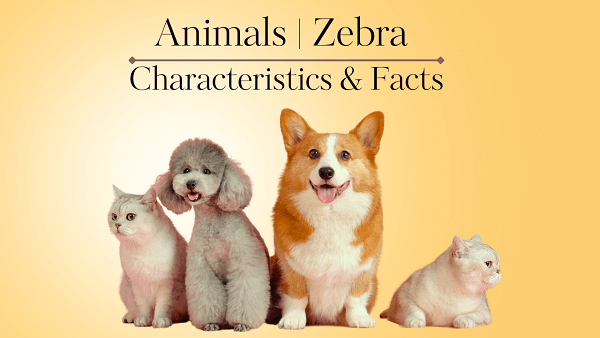Zebra Definition | Characteristics & Facts
Home » Animals » Zebra Definition | Characteristics & Facts
Zebra Definition
Zebras are herbivorous mammals native to Africa, characterized by their distinctive black and white striped coats. They are part of the equine family and are known for their social behavior and unique stripe patterns, which serve as camouflage and deter predators.
Zebra General Characteristics & Facts
Species and Habitat
There are three main species of zebras: the plains zebra (Equus quagga), the mountain zebra (Equus zebra), and the Grevy’s zebra (Equus grevyi). They are native to various regions of Africa, including savannas, grasslands, woodlands, and mountains.
Physical Appearance
Zebras have a horse-like body shape with long legs, a large head, and a mane. Their most recognizable feature is their black-and-white striped coat, which is unique to each individual zebra. The patterns of stripes can vary between species, with plains zebras having broad and close-set stripes, while Grevy’s zebras have thinner and widely spaced stripes.
Social Behavior
Zebras are highly social animals and usually live in family groups known as herds. These herds are composed of one dominant male, called a stallion, multiple females, and their offspring.
Diet
Zebras are herbivores and primarily feed on grasses. They have adapted to graze on tough, coarse grasses found in their habitats. Zebras also have elongated, sharp front teeth called incisors, which they use to crop and tear the grass.
Predators
Zebras face predation from several carnivores in their natural habitats, including lions, hyenas, leopards, and wild dogs. The striped coat of a zebra can serve as a form of camouflage by making it difficult for predators to single out an individual zebra from a moving herd.
Reproduction
Female zebras, called mares, typically give birth to a single foal after a gestation period of around 12-13 months. The foals can stand and walk within an hour of birth and start eating grass within a week. They depend on their mothers for milk and protection in their early stages of life.
Endangered Status
While the plains zebra and mountain zebra populations are relatively stable, the Grevy’s zebra is considered endangered. Loss of habitat, competition with livestock, and hunting for their skins and body parts have led to a decline in Grevy’s zebra numbers.
Unique Adaptations
Zebras have evolved several adaptations to survive in their environments. Their stripes are believed to help deter biting flies and other parasites that are attracted to large areas of a single color.
Speed and Mobility
Zebras are known for their agility and speed. They can reach speeds of up to 40-55 kilometers per hour (25-35 miles per hour) to escape predators. They have strong legs and can deliver powerful kicks, which they use for defense when necessary.
Symbolism and Cultural Significance
Zebras are often associated with freedom, individuality, and natural beauty. They have become iconic animals, represented in art, literature, and folklore across various cultures. In some African tribes, zebras hold cultural and spiritual significance.
Read our Animals Encyclopedia with Complete Facts
Physical Characteristics zebra
Zebras are distinctive, medium-sized ungulates known for their black-and-white striped coats. Here are the key physical characteristics of zebras:
- Body Size: Zebras are similar in size to horses, with variations among different species. The common plains zebra (Equus quagga) stands about 4 to 5 feet (1.2 to 1.5 meters) tall at the shoulder and has a body length of around 7 to 9 feet (2.1 to 2.7 meters). They typically weigh between 500 to 770 pounds (230 to 350 kilograms).
- Striped Coat: Zebras are famous for their black-and-white striped patterns, which vary among species. The stripes are unique to each individual zebra, much like human fingerprints. The stripes cover the entire body, including the legs and face. The specific stripe patterns differ among species and may be vertical, horizontal, or diagonal.
- Head and Neck: Zebras have elongated heads with rounded ears and large, alert eyes. Their muzzles are elongated, ending in a mobile upper lip that allows them to graze on grasses. Zebras have long necks, enabling them to reach vegetation while grazing.
- Mane: Zebras typically have a short, erect mane along the neck, which stands up straight. The mane is usually dark in color and extends down the neck to the withers (shoulder area). Male zebras tend to have thicker manes than females.
- Hooves: Zebras have sturdy hooves adapted for running and living in various habitats. Their hooves are cloven, divided into two distinct toes. This hoof structure provides stability and grip on different terrain.
- Tail: Zebras have long, tufted tails that end in a brush-like tip. The tail helps keep away insects, such as flies and mosquitoes, which can be bothersome in their natural habitats.
- Teeth: Zebras have specialized teeth adapted for grazing on tough grasses. Their incisor and molar teeth are well-suited for cropping and grinding vegetation.
Continue To Explore All Animals That Start With Z
Scientific Classification of Zebra
Kingdom: Animalia
Phylum: Chordata
Class: Mammalia
Order: Perissodactyla
Family: Equidae
Genus: Equus
Key Locations of zebra without description
- Eastern Africa
- Kenya
- Tanzania
- Uganda
- Ethiopia
- Somalia
- Southern Africa
- South Africa
- Botswana
- Namibia
- Zimbabwe
- Zambia
- Western Africa
- Niger
- Burkina Faso
- Nigeria
- Central Africa
- Democratic Republic of the Congo
- Angola
- Cameroon
- Central African Republic
View All A-Z Animals List
Zebra FAQs
What does zebra eat the Most?
Zebras are herbivorous animals and primarily feed on various types of grasses. Grass forms the main component of their diet and makes up the majority of their food intake. Zebras are well-adapted to graze on different grass species found in their habitats.




Interesting article! I learned a lot about zebra.